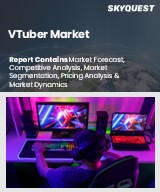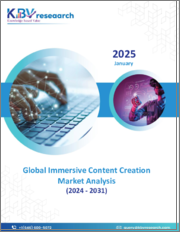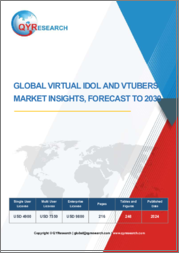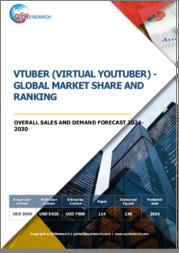
|
시장보고서
상품코드
1754061
가상현실 컨텐츠 제작 시장 보고서 : 컨텐츠 유형, 구성요소, 최종사용자, 지역별(2025-2033년)Virtual Reality Content Creation Market Report by Content Type, Component, End User, and Region 2025-2033 |
||||||
세계 가상현실 컨텐츠 제작 시장 규모는 2024년 75억 달러에 달했습니다. IMARC Group은 2033년까지 2,166억 달러에 달할 것으로 예상하며, 2025년부터 2033년까지 43.12%의 연평균 성장률(CAGR)을 기록할 것으로 전망하고 있습니다. 이 시장은 보다 매력적이고 매혹적인 엔터테인먼트에 대한 욕구에 힘입어 몰입형 디지털 경험에 대한 수요 증가, 차량 설계 및 시뮬레이션에서의 VR 활용 증가, VR 헤드셋의 가용성 증가 등에 힘입어 꾸준한 성장세를 보이고 있습니다.
가상현실 컨텐츠 제작 시장 분석:
- 시장 성장과 규모 : 가상현실(VR) 컨텐츠 제작 시장은 몰입형 경험에 대한 수요 증가로 인해 견조한 성장세를 보이고 있습니다.
- 주요 시장 촉진요인 : 새로운 컨텐츠 개발에 대한 재정적 지원 확대와 사용자 유치 및 브랜드 메시지 전달에 있어 VR 활용의 중요성에 대한 인식이 높아진 것이 주요 시장 촉진요인으로 작용하고 있습니다.
- 기술 발전 : 하드웨어와 소프트웨어를 포함한 VR 기술의 지속적인 발전으로 가상현실 컨텐츠의 품질과 인터랙션이 향상되고 있습니다.
- 산업 응용 : VR 컨텐츠 제작은 게임, 부동산, 의료, 교육, 엔터테인먼트 등 다양한 산업 분야에서 활용되고 있습니다. 이러한 용도는 특정 수요를 충족시켜 시장 확대를 촉진하고 있습니다.
- 주요 시장 동향 : 교육 및 훈련에서의 VR 활용, 사용자의 참여와 관심을 유지하기 위한 다양한 컨텐츠 제공의 중요성이 시장 성장을 촉진하고 있습니다.
- 지리적 동향 : 아시아태평양은 규모, 빠른 기술 도입, 강력한 게임 문화로 인해 시장을 선도하고 있습니다. 그러나 북미는 보다 몰입감 있는 디지털 경험에 대한 대중의 수요가 증가함에 따라 급성장하는 시장으로 부상하고 있습니다.
- 경쟁 상황 : 시장 개발의 주요 기업들은 연구개발(R&D)에 투자하고, 전략적 파트너십을 맺고, 신흥국 시장에 진출하고 있습니다. 또한, 컨텐츠의 다양성을 중시하고, 하드웨어 제조업체와 협력하여 원활한 통합을 도모하고 있습니다.
- 도전과 기회 : 도전과제로는 높은 개발 비용, 컨텐츠 불법 복제에 대한 우려, 사용자 친화적인 인터페이스의 필요성 등이 있습니다. 그러나 신흥 시장의 미개발 가능성, 지속적인 기술 발전, 헬스케어 및 교육 분야로의 적용 등의 기회가 이러한 도전과제를 극복할 것으로 예상됩니다.
가상현실 컨텐츠 제작 시장 동향:
몰입형 경험에 대한 수요 증가
몰입형 경험에 대한 대중의 수요가 증가함에 따라 시장 성장의 원동력이 되고 있습니다. 사람들은 점점 더 가상 세계에 들어가서 의미 있는 상호작용을 할 수 있는 컨텐츠에 대한 수요가 증가하고 있습니다. 이러한 수요는 엔터테인먼트, 교육, 커뮤니케이션을 보다 매력적이고 매혹적인 형태로 만들고자 하는 열망으로 인해 더욱 가속화되고 있습니다. 기술이 계속 발전함에 따라 가상현실은 그 어느 때보다 더 깊은 몰입감을 약속합니다. 가상현실(VR) 헤드셋, 컨트롤러, 햅틱 피드백 장치는 가상 환경 내에서의 몰입감을 높이기 위해 진화해 왔습니다. 이러한 몰입감의 증가는 이러한 기능을 최대한 활용할 수 있는 고품질 VR 컨텐츠에 대한 수요를 촉진하고 있습니다. 기업들은 혁신적이고 영향력 있는 방식으로 시청자를 사로잡을 수 있는 VR의 잠재력을 인식하고 있습니다. 가상 제품 데모부터 몰입형 교육 시뮬레이션에 이르기까지 다양한 산업 분야에서 VR을 활용해 고객 경험을 개선하고 직원 교육을 개선하는 데 활용하고 있습니다. 이에 따라 컨텐츠 제작자들은 재미뿐만 아니라 가치와 실용성을 제공하는 컨텐츠 제작에 집중하고 있습니다.
VR 애플리케이션 확대
다양한 산업 분야에서의 VR 적용 확대가 시장 성장에 기여하고 있으며, VR은 초기 게임 산업에서 각광을 받았지만, 그 범위는 이제 엔터테인먼트를 훨씬 뛰어넘어 확장되고 있습니다. 헬스케어 분야에서는 의료 교육, 통증 관리 및 치료에 VR이 활용되고 있습니다. 교육 기관에서는 커리큘럼에 VR을 도입하여 학습 경험을 향상시키고 있습니다. 부동산 전문가는 VR을 활용하여 구매 희망자에게 가상 부동산 투어를 제공하고 있습니다. 자동차 회사는 차량 설계 및 시뮬레이션에 VR을 활용하고 있습니다. 이는 VR이 다양한 분야에 혁명을 불러일으키고 있는 사례 중 일부에 불과합니다. 이처럼 VR의 용도가 다양해짐에 따라 맞춤형 컨텐츠에 대한 수요가 크게 증가하고 있습니다. 각 산업 분야는 각자의 요구에 맞는 독특하고 전문적인 가상현실 경험을 필요로 합니다. 컨텐츠 개발자들은 이러한 기회를 포착하여 해당 산업에 가치, 효율성, 혁신을 제공하는 맞춤형 VR 솔루션을 개발하고 있으며, VR의 범용성과 효과가 계속 입증됨에 따라 더 많은 기업들이 VR을 업무에 통합하는 방법을 모색하고 있습니다. 이러한 VR 애플리케이션의 확장된 전망은 컨텐츠 제작에 대한 안정적인 수요를 보장합니다.
기술 발전
현재 진행 중인 기술 발전으로 VR 컨텐츠 제작과 관련된 다양한 측면이 개선되고 있습니다. 하드웨어와 소프트웨어의 기능이 계속 발전함에 따라 컨텐츠 제작자들은 더 높은 품질과 몰입감 있는 VR 경험을 제공하는 데 필요한 도구를 갖추게 되었습니다. 하드웨어 측면에서는 VR 헤드셋과 주변기기가 더욱 강력해지고 가격이 저렴해지고 있습니다. 고해상도 디스플레이, 개선된 트래킹 시스템, 인체공학적 디자인은 보다 편안하고 시각적으로 인상적인 VR 경험을 제공하는 데 기여하고 있습니다. 이러한 디바이스가 대중화됨에 따라 이를 활용할 수 있는 컨텐츠에 대한 수요도 증가하고 있으며, VR 컨텐츠 제작을 위한 소프트웨어 툴도 빠르게 발전하고 있습니다. 컨텐츠 제작자들은 고급 3D 모델링 및 애니메이션 소프트웨어, 개발 프로세스를 효율화할 수 있는 게임 엔진을 사용할 수 있게 되었습니다. 이러한 툴을 통해 크리에이터들은 복잡한 가상 세계, 사실적인 캐릭터, 인터랙티브 시나리오를 보다 쉽고 효율적으로 디자인할 수 있게 되었습니다. 또한, 인공지능(AI)과 머신러닝(ML)의 기술 발전도 VR 컨텐츠를 강화하는 데 일조하고 있으며, AI 기반 알고리즘은 그래픽을 최적화하고, 자연스러운 움직임을 시뮬레이션하며, 사용자의 행동과 취향에 따라 경험을 개인화할 수 있습니다.
목차
제1장 서문
제2장 조사 범위와 조사 방법
- 조사 목적
- 이해관계자
- 데이터 소스
- 1차 정보
- 2차 정보
- 시장 추정
- 상향식 접근
- 하향식 접근
- 조사 방법
제3장 주요 요약
제4장 소개
- 개요
- 주요 업계 동향
제5장 세계의 가상현실 컨텐츠 제작 시장
- 시장 개요
- 시장 실적
- COVID-19의 영향
- 시장 예측
제6장 시장 내역 : 컨텐츠 유형별
- 비디오
- 360도 사진
- 게임
제7장 시장 내역 : 구성요소별
- 소프트웨어
- 서비스
제8장 시장 내역 : 최종사용자별
- 부동산
- 여행과 호스피탈리티
- 미디어와 엔터테인먼트
- 헬스케어
- 소매
- 게임
- 자동차
- 기타
제9장 시장 내역 : 지역별
- 북미
- 미국
- 캐나다
- 아시아태평양
- 중국
- 일본
- 인도
- 한국
- 호주
- 인도네시아
- 기타
- 유럽
- 독일
- 프랑스
- 영국
- 이탈리아
- 스페인
- 러시아
- 기타
- 라틴아메리카
- 브라질
- 멕시코
- 기타
- 중동 및 아프리카
- 시장 내역 : 국가별
제10장 SWOT 분석
- 개요
- 강점
- 약점
- 기회
- 위협
제11장 밸류체인 분석
제12장 Porter's Five Forces 분석
- 개요
- 구매자의 교섭력
- 공급 기업의 교섭력
- 경쟁 정도
- 신규 참여업체의 위협
- 대체품의 위협
제13장 가격 분석
제14장 경쟁 구도
- 시장 구조
- 주요 기업
- 주요 기업 개요
- 360 Labs
- Blippar Group Limited
- Dell Inc
- Koncept VR LLC
- Matterport Inc.
- Panedia Pty Ltd.
- Scapic Innovations Private Limited
- Subvrsive
- VIAR Inc
- WeMakeVR
The global virtual reality content creation market size reached USD 7.5 Billion in 2024. Looking forward, IMARC Group expects the market to reach USD 216.6 Billion by 2033, exhibiting a growth rate (CAGR) of 43.12% during 2025-2033. The market is experiencing steady growth driven by the escalating demand for immersive digital experiences fueled by the desire for more engaging and captivating forms of entertainment, rising utilization of VR for vehicle design and simulation, and increasing availability of VR headsets.
Virtual Reality Content Creation Market Analysis:
- Market Growth and Size: The virtual reality (VR) content creation market is experiencing robust growth due to increasing demand for immersive experiences.
- Major Market Drivers: The growing financial support for the development of new content and rising awareness about the importance of using VR in engaging users and conveying brand messages are major drivers of the market.
- Technological Advancements: Ongoing advancements in VR technology, including hardware and software, are enhancing the quality and interactivity of virtual reality content.
- Industry Applications: VR content creation finds applications in diverse industries, including gaming, real estate, healthcare, education, and entertainment. These applications cater to specific needs and drive market expansion.
- Key Market Trends: The use of VR in education and training, and the importance of diverse content offerings to maintain user engagement and interest is facilitating the market growth.
- Geographical Trends: Asia Pacific leads the market due to its size, rapid technological adoption, and strong gaming culture. However, North America is emerging as a fast-growing market on account of the rising demand for enhanced and immersive digital experiences among the masses.
- Competitive Landscape: Key players in the market are investing in research and development (R&D), forming strategic partnerships, and expanding into emerging markets. They are focusing on content diversity and collaborating with hardware manufacturers to ensure seamless integration.
- Challenges and Opportunities: Challenges include high development costs, content piracy concerns, and the need for user-friendly interfaces. Nonetheless, opportunities for the untapped potential of emerging markets, continued technological advancements and applications in healthcare and education sectors are projected to overcome these challenges.
Virtual Reality Content Creation Market Trends:
Growing Demand for Immersive Experiences
The rising demand for immersive experiences among the masses is impelling the growth of the market. People are increasingly seeking content that allows them to step into a virtual world and interact with it in a meaningful way. This demand is fueled by the desire for more engaging and captivating forms of entertainment, education, and communication. As technology continues to advance, virtual reality offers the promise of a deeper level of immersion than ever before. Virtual reality (VR) headsets, controllers, and haptic feedback devices have evolved to provide users with a heightened sense of presence within virtual environments. This heightened sense of presence drives the demand for high-quality VR content that can fully leverage these capabilities. Businesses are recognizing the potential of VR to engage their viewers in innovative and impactful ways. From virtual product demonstrations to immersive training simulations, VR is being used across various industries to enhance customer experiences and improve employee training. As a result, content creators are focusing on delivering content that not only entertains but also provides value and utility.
Expansion of VR Applications
The expansion of VR applications across diverse industries is contributing to the market growth. While VR initially gained prominence in the gaming industry, its reach has now extended far beyond entertainment. In the healthcare sector, VR is being used for medical training, pain management, and therapy. Educational institutions are incorporating VR into their curriculum to enhance learning experiences. Real estate professionals are utilizing VR to offer virtual property tours to potential buyers. Automotive companies are using VR for vehicle design and simulation. These are just a few examples of how VR is revolutionizing various sectors. This diversification of VR applications is creating a substantial demand for tailored content. Each industry requires unique and specialized virtual reality experiences that cater to its specific needs. Content creators are seizing this opportunity to develop customized VR solutions that provide value, efficiency, and innovation to these industries. As VR continues to prove its versatility and effectiveness, more businesses are exploring ways to integrate it into their operations. This expanding landscape of VR applications ensures a steady demand for content creation.
Technological Advancements
The ongoing technological advancements are improving various aspects associated with VR content creation. As hardware and software capabilities continue to evolve, content creators have the tools needed to deliver higher-quality and more immersive VR experiences. On the hardware front, VR headsets and peripherals are becoming more powerful and affordable. High-resolution displays, improved tracking systems, and ergonomic designs contribute to a more comfortable and visually impressive VR experience. As these devices become more accessible to people, the demand for content that can leverage their capabilities grows. Software tools for VR content creation are also advancing rapidly. Content creators now have access to sophisticated 3D modeling and animation software, as well as game engines that streamline the development process. These tools enable creators to design intricate virtual worlds, realistic characters, and interactive scenarios with greater ease and efficiency. Additionally, technological improvements in artificial intelligence (AI) and machine learning (ML) play a role in enhancing VR content. AI-driven algorithms can optimize graphics, simulate natural movements, and even personalize experiences based on user behavior and preferences.
Virtual Reality Content Creation Industry Segmentation:
Breakup by Content Type:
- Videos
- 360 Degree Photos
- Games
Videos account for the majority of the market share
Video content stands out as the largest segment within the virtual reality (VR) content creation market. This dominance can be attributed to the broad appeal and versatility of video in delivering immersive experiences. From cinematic storytelling to educational tutorials, VR videos offer users a wide range of engaging content. Businesses and content creators recognize the potential of VR videos in captivating audiences and fostering deeper connections. This segment continues to expand as VR technology advances, leading to higher-resolution videos and more interactive experiences.
The 360-degree photos segment plays a significant role in offering immersive snapshots of environments and products. 360-degree photos find applications in real estate, tourism, and product showcasing, allowing users to explore a location or product from all angles. This segment caters to businesses seeking to provide interactive visual experiences to their customers.
Virtual reality (VR) games have long been a driving force behind VR adoption, due to their ability to transport users to fantastical worlds and offer highly interactive experiences. This segment encompasses a wide range of genres, from action-packed adventures to immersive simulations. VR game developers leverage technological capabilities to create captivating and physically engaging experiences, attracting gamers and enthusiasts alike.
Breakup by Component:
- Software
- Services
Software holds the largest share in the industry
Software represents the largest segment within the virtual reality (VR) content creation market. The significance of software can be attributed to its pivotal role in designing, developing, and optimizing VR experiences. Content creators rely on sophisticated 3D modeling, animation software, and game engines to craft immersive VR environments, characters, and interactions. Additionally, software plays a crucial role in optimizing graphics, simulating natural movements, and personalizing experiences based on user behavior. The availability of powerful and user-friendly VR content creation software tools continues to attract a growing community of developers and content creators.
Virtual reality content creation services are a vital component of modern marketing and communication strategies. These services encompass the development of immersive and interactive experiences using virtual reality technology. Tailored VR solutions that align with your specific goals and requirements are crucial. A provider that can customize VR content to your brand and objectives will enhance engagement and user satisfaction.
Breakup by End User:
- Real Estate
- Travel and Hospitality
- Media and Entertainment
- Healthcare
- Retail
- Gaming
- Automotive
- Others
Gaming represents the leading market segment
The gaming industry stands as the largest segment within the virtual reality (VR) content creation market. Virtual reality gaming is a driving force behind the adoption of VR technology, offering players immersive and interactive experiences that transcend traditional gaming. The demand for VR games continues to soar as developers leverage the capabilities of the technology to create captivating and physically engaging content. Gamers are drawn to VR for its ability to transport them to fantastical worlds and provide unparalleled immersion. This segment encompasses a wide range of gaming genres, from action-packed adventures to simulation games, and it plays a pivotal role in advancing VR technology as a whole.
The real estate industry has embraced VR as a powerful tool for property showcasing and visualization. Virtual property tours and immersive 3D walkthroughs are becoming popular among real estate professionals and potential buyers. This segment caters to those seeking to explore properties remotely and make more informed decisions.
The travel and hospitality sector are recognizing the potential of VR in improving the customer experience. VR is used to provide virtual tours of hotels, resorts, and tourist destinations, allowing travelers to explore and make informed decisions before booking. This segment offers travelers a taste of their destination, fostering anticipation and excitement.
VR is making a significant impact on the media and entertainment industry, offering new avenues for storytelling and engagement. This segment includes VR content for films, documentaries, and interactive storytelling experiences. VR technology allows creators to transport audiences into the heart of their narratives, providing a level of immersion and engagement that traditional media cannot match.
The healthcare industry has adopted VR for various applications, such as medical training, therapy, and pain management. VR simulations offer medical professionals a safe and realistic environment to practice surgical procedures and improve their skills. In therapy, VR is used for exposure therapy, pain distraction, and rehabilitation exercises.
Breakup by Region:
- North America
- United States
- Canada
- Asia-Pacific
- China
- Japan
- India
- South Korea
- Australia
- Indonesia
- Others
- Europe
- Germany
- France
- United Kingdom
- Italy
- Spain
- Russia
- Others
- Latin America
- Brazil
- Mexico
- Others
- Middle East and Africa
Asia Pacific leads the market, accounting for the largest virtual reality content creation market share
The market research report has also provided a comprehensive analysis of all the major regional markets, which include North America (the United States and Canada); Asia Pacific (China, Japan, India, South Korea, Australia, Indonesia, and others); Europe (Germany, France, the United Kingdom, Italy, Spain, Russia, and others); Latin America (Brazil, Mexico, and others); and the Middle East and Africa. According to the report, Asia Pacific accounted for the largest market share.
The Asia Pacific virtual reality content creation market is driven by the increasing availability of virtual reality (VR) devices, government support, and the growing gaming and entertainment industry. Educational institutions and businesses are leveraging VR for immersive learning and realistic simulations.
North America maintains a strong presence driven by the need for remote collaboration and the desire to reduce travel costs in the enterprise sector.
Europe stands as another key region in the market, driven by the increasing government initiatives to promote VR innovation in education, healthcare, and entertainment.
Latin America exhibits growing potential in the virtual reality content creation market, fueled by the increasing interest in VR entertainment and gaming.
The Middle East and Africa region show a developing market for virtual reality content creation, driven by the increasing focus on VR content development, especially in sectors like education and healthcare, to drive innovation and economic growth.
Leading Key Players in the Virtual Reality Content Creation Industry:
Key players in the virtual reality (VR) content creation market are actively pursuing several strategies to maintain their competitive edge. They are heavily investing in research and development (R&D) to create cutting-edge VR content and technology. This includes developing immersive storytelling experiences, high-quality VR games, and educational simulations. Additionally, these companies are forging partnerships and collaborations with VR hardware manufacturers to ensure seamless integration and optimize user experiences. They are also expanding their reach into emerging markets to tap into the growing user base. Furthermore, key players are focusing on content diversity to cater to various industries, including healthcare, real estate, and entertainment, thereby diversifying their revenue streams and solidifying their positions as industry leaders.
The market research report has provided a comprehensive analysis of the competitive landscape. Detailed profiles of all major companies have also been provided. Some of the key players in the market include:
- 360 Labs
- Blippar Group Limited
- Dell Inc
- Koncept VR LLC
- Matterport Inc.
- Panedia Pty Ltd.
- Scapic Innovations Private Limited
- Subvrsive
- VIAR Inc
- WeMakeVR
Key Questions Answered in This Report
- 1.How big is the global virtual reality content creation market?
- 2.What is the expected growth rate of the global virtual reality content creation market during 2025-2033?
- 3.What are the key factors driving the global virtual reality content creation market?
- 4.What has been the impact of COVID-19 on the global virtual reality content creation market?
- 5.What is the breakup of the global virtual reality content creation market based on the content type?
- 6.What is the breakup of the global virtual reality content creation market based on the component?
- 7.What is the breakup of the global virtual reality content creation market based on the end user?
- 8.What are the key regions in the global virtual reality content creation market?
- 9.Who are the key players/companies in the global virtual reality content creation market?
Table of Contents
1 Preface
2 Scope and Methodology
- 2.1 Objectives of the Study
- 2.2 Stakeholders
- 2.3 Data Sources
- 2.3.1 Primary Sources
- 2.3.2 Secondary Sources
- 2.4 Market Estimation
- 2.4.1 Bottom-Up Approach
- 2.4.2 Top-Down Approach
- 2.5 Forecasting Methodology
3 Executive Summary
4 Introduction
- 4.1 Overview
- 4.2 Key Industry Trends
5 Global Virtual Reality Content Creation Market
- 5.1 Market Overview
- 5.2 Market Performance
- 5.3 Impact of COVID-19
- 5.4 Market Forecast
6 Market Breakup by Content Type
- 6.1 Videos
- 6.1.1 Market Trends
- 6.1.2 Market Forecast
- 6.2 360 Degree Photos
- 6.2.1 Market Trends
- 6.2.2 Market Forecast
- 6.3 Games
- 6.3.1 Market Trends
- 6.3.2 Market Forecast
7 Market Breakup by Component
- 7.1 Software
- 7.1.1 Market Trends
- 7.1.2 Market Forecast
- 7.2 Services
- 7.2.1 Market Trends
- 7.2.2 Market Forecast
8 Market Breakup by End User
- 8.1 Real Estate
- 8.1.1 Market Trends
- 8.1.2 Market Forecast
- 8.2 Travel and Hospitality
- 8.2.1 Market Trends
- 8.2.2 Market Forecast
- 8.3 Media and Entertainment
- 8.3.1 Market Trends
- 8.3.2 Market Forecast
- 8.4 Healthcare
- 8.4.1 Market Trends
- 8.4.2 Market Forecast
- 8.5 Retail
- 8.5.1 Market Trends
- 8.5.2 Market Forecast
- 8.6 Gaming
- 8.6.1 Market Trends
- 8.6.2 Market Forecast
- 8.7 Automotive
- 8.7.1 Market Trends
- 8.7.2 Market Forecast
- 8.8 Others
- 8.8.1 Market Trends
- 8.8.2 Market Forecast
9 Market Breakup by Region
- 9.1 North America
- 9.1.1 United States
- 9.1.1.1 Market Trends
- 9.1.1.2 Market Forecast
- 9.1.2 Canada
- 9.1.2.1 Market Trends
- 9.1.2.2 Market Forecast
- 9.1.1 United States
- 9.2 Asia-Pacific
- 9.2.1 China
- 9.2.1.1 Market Trends
- 9.2.1.2 Market Forecast
- 9.2.2 Japan
- 9.2.2.1 Market Trends
- 9.2.2.2 Market Forecast
- 9.2.3 India
- 9.2.3.1 Market Trends
- 9.2.3.2 Market Forecast
- 9.2.4 South Korea
- 9.2.4.1 Market Trends
- 9.2.4.2 Market Forecast
- 9.2.5 Australia
- 9.2.5.1 Market Trends
- 9.2.5.2 Market Forecast
- 9.2.6 Indonesia
- 9.2.6.1 Market Trends
- 9.2.6.2 Market Forecast
- 9.2.7 Others
- 9.2.7.1 Market Trends
- 9.2.7.2 Market Forecast
- 9.2.1 China
- 9.3 Europe
- 9.3.1 Germany
- 9.3.1.1 Market Trends
- 9.3.1.2 Market Forecast
- 9.3.2 France
- 9.3.2.1 Market Trends
- 9.3.2.2 Market Forecast
- 9.3.3 United Kingdom
- 9.3.3.1 Market Trends
- 9.3.3.2 Market Forecast
- 9.3.4 Italy
- 9.3.4.1 Market Trends
- 9.3.4.2 Market Forecast
- 9.3.5 Spain
- 9.3.5.1 Market Trends
- 9.3.5.2 Market Forecast
- 9.3.6 Russia
- 9.3.6.1 Market Trends
- 9.3.6.2 Market Forecast
- 9.3.7 Others
- 9.3.7.1 Market Trends
- 9.3.7.2 Market Forecast
- 9.3.1 Germany
- 9.4 Latin America
- 9.4.1 Brazil
- 9.4.1.1 Market Trends
- 9.4.1.2 Market Forecast
- 9.4.2 Mexico
- 9.4.2.1 Market Trends
- 9.4.2.2 Market Forecast
- 9.4.3 Others
- 9.4.3.1 Market Trends
- 9.4.3.2 Market Forecast
- 9.4.1 Brazil
- 9.5 Middle East and Africa
- 9.5.1 Market Trends
- 9.5.2 Market Breakup by Country
- 9.5.3 Market Forecast
10 SWOT Analysis
- 10.1 Overview
- 10.2 Strengths
- 10.3 Weaknesses
- 10.4 Opportunities
- 10.5 Threats
11 Value Chain Analysis
12 Porters Five Forces Analysis
- 12.1 Overview
- 12.2 Bargaining Power of Buyers
- 12.3 Bargaining Power of Suppliers
- 12.4 Degree of Competition
- 12.5 Threat of New Entrants
- 12.6 Threat of Substitutes
13 Price Analysis
14 Competitive Landscape
- 14.1 Market Structure
- 14.2 Key Players
- 14.3 Profiles of Key Players
- 14.3.1 360 Labs
- 14.3.1.1 Company Overview
- 14.3.1.2 Product Portfolio
- 14.3.2 Blippar Group Limited
- 14.3.2.1 Company Overview
- 14.3.2.2 Product Portfolio
- 14.3.3 Dell Inc
- 14.3.3.1 Company Overview
- 14.3.3.2 Product Portfolio
- 14.3.3.3 Financials
- 14.3.3.4 SWOT Analysis
- 14.3.4 Koncept VR LLC
- 14.3.4.1 Company Overview
- 14.3.4.2 Product Portfolio
- 14.3.5 Matterport Inc.
- 14.3.5.1 Company Overview
- 14.3.5.2 Product Portfolio
- 14.3.6 Panedia Pty Ltd.
- 14.3.6.1 Company Overview
- 14.3.6.2 Product Portfolio
- 14.3.7 Scapic Innovations Private Limited
- 14.3.7.1 Company Overview
- 14.3.7.2 Product Portfolio
- 14.3.8 Subvrsive
- 14.3.8.1 Company Overview
- 14.3.8.2 Product Portfolio
- 14.3.9 VIAR Inc
- 14.3.9.1 Company Overview
- 14.3.9.2 Product Portfolio
- 14.3.10 WeMakeVR
- 14.3.10.1 Company Overview
- 14.3.10.2 Product Portfolio
- 14.3.1 360 Labs



















